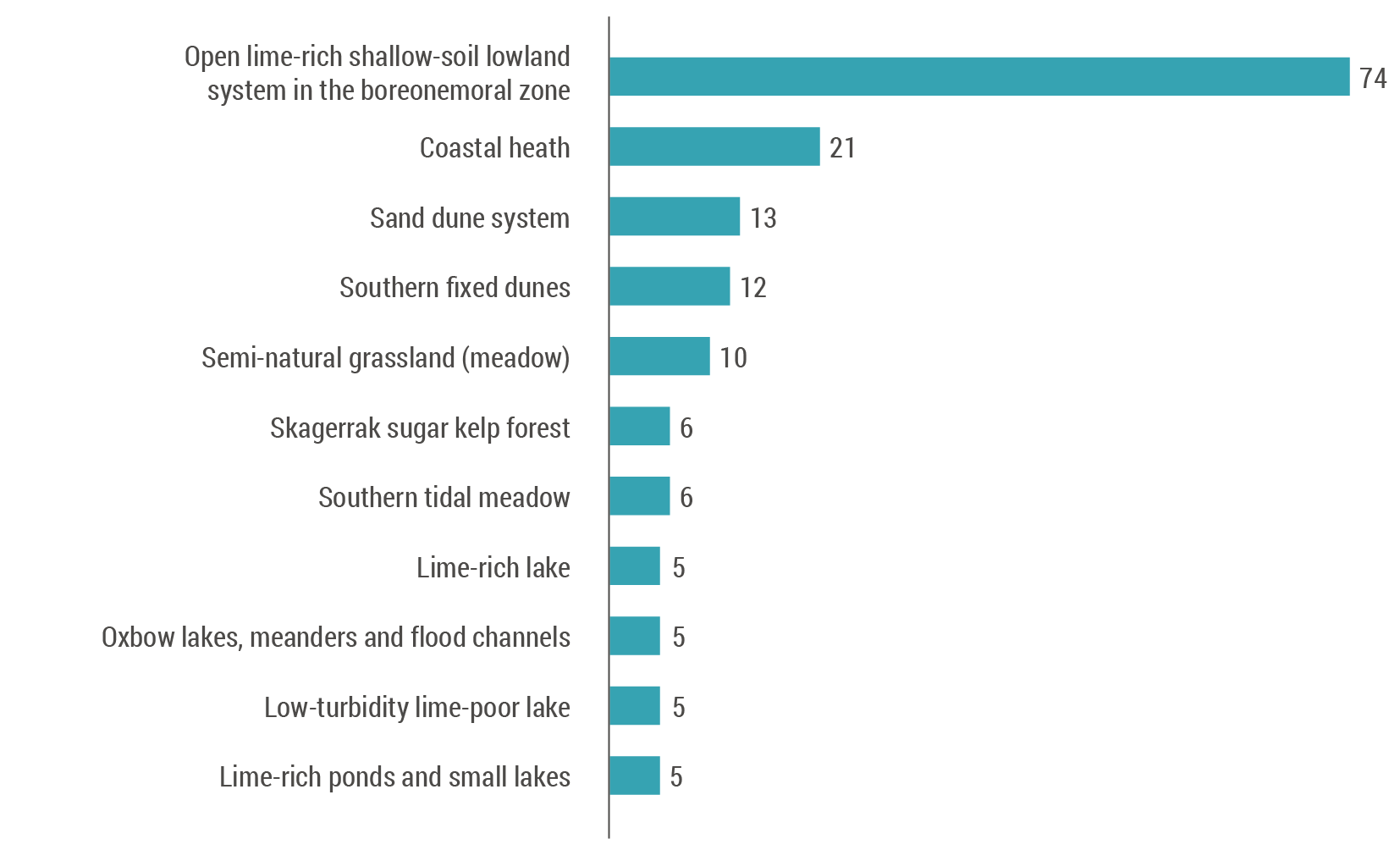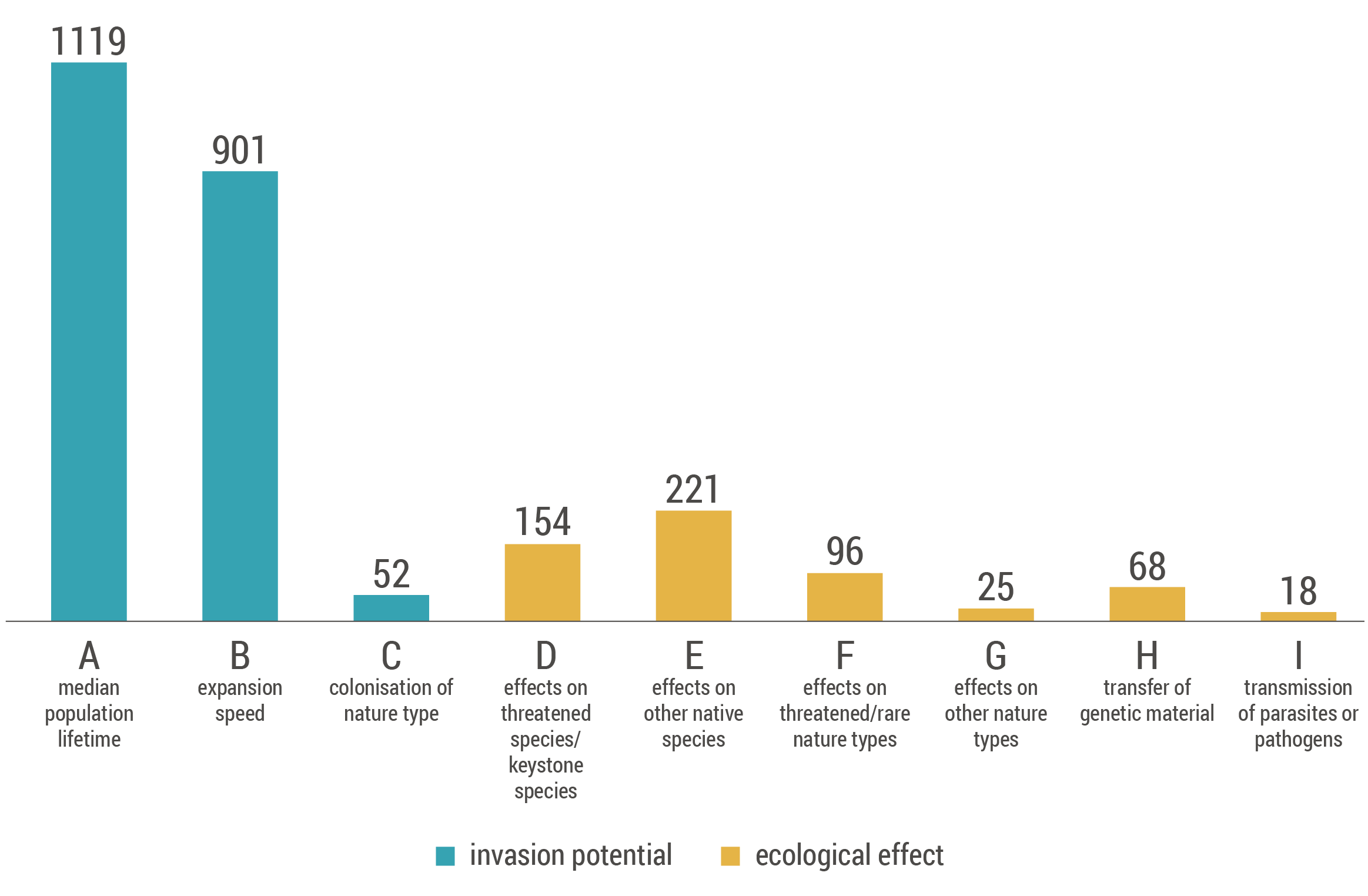How is biodiversity affected?
A species can have an ecological risk for many different reasons. In the 2018 results, the most common effect an alien species can have is competition with autochthonous (native) species.
- Innhold
- High life expectancy and expansion speed (criteria A – C)
- Competition with threatened native species (criteria D and E)
- Impacts on Red Listed nature types (criteria F and G)
High life expectancy and expansion speed (criteria A – C)
For the majority of species, it is the life expectancy in Norway (criterion A) combined with its expansion speed (criterion B) that determines the magnitude of its invasion potential.
Many of the alien species (374 in total) are assessed as being able to maintain viable populations in Norway for ≥650 years (corresponds to sub-category 4, criterion A). 354 species are expected to have a short life span ie. less than 10 years (sub-category 1, criterion A).
170 species have an expansion speed that is greater than 500 m per year (sub-category 4, criterion B), while all 572 have an expansion speed that is less than 50 m per year (sub-category 1, criterion B). The majority of these species have no known impact in Norway.
Alien species colonise many different nature types but estimates show that in most cases they cover a small proportion of the nature type's area. Only 8 species have an area of occurrence which comprises, or has the potential to comprise, ≥5 % of at least one nature type in the course of 50 years. An example is Canada goose Branta canadensis which has colonised more than 20 % of the tidal meadow nature type.
Competition with threatened native species (criteria D and E)
In total, 154 species have been assessed as having either a potential, or real, negative effect on threatened native species or keystone species (criterion D). The risk level severe impact SE is indicated for 48 species in total. These species can therefore cause a significant reduction in the population size of at least one threatened species or keystone species.
The fungus Hymenoscyphus fraxineus is one of the species in this group because it has a negative effect on European ash Fraxinus excelsior. European ash is categorized as vulnerable VU in the Norwegian Red List for Species 2010.
Furthermore, 221 species are registered as having a potentially negative effect on other native species in Norway (criterion E).
Impacts on Red Listed nature types (criteria F and G)
Of those species which are risk-assessed, 96 have the potential to cause a change in the state of one or more nature types in Norway (criterion F). The majority of these are vascular plants and 12 of these are species which impact ≥5 % of the area of the nature type eg. low juneberry Amelanchier spicata, Rugosa rose Rosa rugosa, the seaweed Dasysiphonia japonica and sycamore Acer pseudoplatanus. The seaweed invades sugar kelp forests, while Rugosa rose colonises sand dune systems.
The threatened nature type which is most frequently identified in connection with this criterion is the open lime-rich shallow-soil lowland system in boreonemoral zone, categorized as vulnerable VU. More than 70 species are indicated as causing, or being able to cause, a change in the state of this nature type.
Nature types in Norway which are neither threatened nor rare can also change as a result of the influence of alien species. This is indicated for 25 species.
Transfer of genetic material requires that which we call introgression. Hybridization alone is not enough. Genes are considered to have been transferred to a native species if a backcross occurs between hybrids and the native population. This has happened, or is likely to happen, to 68 of the assessed alien species.
Scotch broom Cytisus scoparius is native in parts of Norway but there are also alien variants which have been imported by garden centres and later gone wild. The imported variants can genetically "pollute" native populations. The hybrid yew Taxus x media, poses a severe impact risk for several reasons, including the likelihood that it can transfer genes to the native yew Taxus baccata, which is assessed as being vulnerable in the Norwegian Red List for Species.
Transfer of genetic material requires that which we call introgression. Hybridization alone is not enough. Genes are considered to have been transferred to a native species if a backcross occurs between hybrids and the native population. This has happened, or is likely to happen, to 68 of the assessed alien species.
Scotch broom Cytisus scoparius is native in parts of Norway but there are also alien variants which have been imported by garden centres and later gone wild. The imported variants can genetically "pollute" native populations. The hybrid yew Taxus x media, poses a severe impact risk for several reasons, including the likelihood that it can transfer genes to the native yew Taxus baccata, which is assessed as being vulnerable in the Norwegian Red List for Species.
Among the alien species, 18 species are indentified as having the potential to transmit parasites and/or pathogens to native organisms.
Rainbow trout Oncorhynchus mykiss is an example of an alien species which has a severe impact risk assessment, and which can transmit the parasite Gyrodactylus salaris to the native salmon Salmo salar. Hollyberry cotoneaster Cotoneaster bullatus is another example. This garden shrub can transmit the serious plant disease, fire blight, to for example the European crab apple (wild apple) Malus sylvestris.
The number of species where the sub-category is greater than 1 for each criterion A-I. For criterion A this means that the median life expectancy is greater than or equal to 10 years, for criterion B this encompasses species where the expansion speed is greater than or equal to 50 m/year, and for criterion C, species which colonise more than or equal to 5 % of a nature type. For the remaining criteria D-I, a sub-category greater than 1 implies that the species has an ecological effect.

